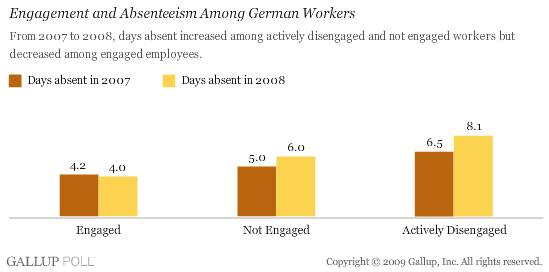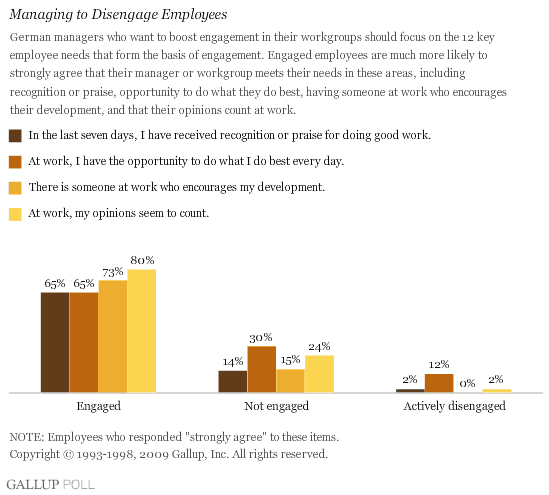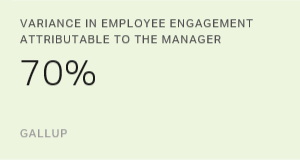The vast majority of the German workforce is not engaged with its work. Though not a hot topic at last week's G-20 summit, this finding presents a serious threat to productivity -- and ultimately to the Federal Republic of Germany's gross domestic product -- because a company's potential for achievement depends significantly on the attitudes and motivation level of its employees.
And Germany needs more engaged workers. There is considerable economic competition between the European Union countries -- especially the countries in Eastern Europe, where labor costs are often lower. Germany has the highest population and the highest GDP in the EU, and it is the biggest net payer. Because of that, it has a bigger impact on the European economic climate than any other EU country.
Yet Germany's competitiveness in the global economy could be undermined by the low productivity and reduced profitability that accompany disengagement. Germany is positioned well for future growth -- but its high percentage of actively disengaged workers is putting its current and future economic stability at risk.
What the survey says
According to a 2008 Gallup employee engagement survey, only 13% of German employees are engaged with their workplace, while 67% are not engaged, and 20% are actively disengaged. Gallup measures employee engagement using 12 items that link to key business outcomes -- including employee retention, productivity, profitability, customer engagement, and safety -- and that reflect basic human needs and expectations in the workplace. When these needs are met, employees can become engaged, or psychologically committed, to their workplace.

That's why it's alarming that the majority of Germany's labor force -- estimated at more than 33 million employees, many of whom work the longest hours in the EU -- lack commitment to their workplaces. Gallup estimates that actively disengaged employees cost the German economy between 81.2 billion and 109 billion euros per year in lost productivity alone. This does not include additional costs to the economy due to absenteeism, lack of innovation and customer orientation, high turnover, and negative word-of-mouth.
Absenteeism. In Germany, on average, actively disengaged employees miss eight days of work per year, while engaged employees miss only four days per year. From 2007 to 2008, absenteeism increased 1.6 days per year among actively disengaged workers and 1 day per year among not engaged workers -- but absenteeism decreased slightly (.2 days per year) among engaged employees.
It's interesting to note that there is a pattern between the economic climate and days absent: As overall employment increases, the average number of days employees miss each year decreases, but as overall employment decreases, the average number of days employees are absent from work increases. When Gallup researchers compared this finding with our engagement data, we found that this pattern holds true for employees who are not engaged or actively disengaged but not for employees who are engaged. This pattern was the same in 2008; at the time the survey was conducted, the economic situation was satisfactory, and unemployment rates were steadily decreasing. (See graphic "Engagement and Absenteeism Among German Workers.")

Lack of innovation. When asked to rate their level of agreement with the statement "My current job brings out my most creative ideas," 48% of engaged employees strongly agreed, while only 3% of actively disengaged employees strongly agreed. This suggests that higher levels of employee engagement increase the likelihood that employees will generate new ideas, which is a powerful factor in catalyzing innovation. And the survey shows that engaged employees contributed an average of 9.8 ideas for improvement in the six months preceding the survey -- significantly more than actively disengaged employees, who contributed an average of 3.4 suggestions over the same time frame.
Lack of customer orientation. In a challenging economy where the competition for customers can be fierce, a workforce of engaged employees could be a crucial advantage in retaining customers. Gallup's research reveals that the higher the level of employee disengagement, the lower the level of customer orientation. Among engaged employees with direct and regular customer contact, 66% strongly agree that "meeting customer requests and needs drives my daily action," while only 35% of actively disengaged employees strongly agree with this statement. In general, engaged employees with regular, direct customer contact are more likely to strongly agree that "customers' comments and suggestions always lead to concrete improvement actions in our company" (57%) than are actively disengaged employees (4%). Engaged employees also tend to think about how customer service could be optimized. For example, 51% of engaged workers agree that "I often think about how we can improve the service for our customers," but only 16% of actively disengaged workers agree with this statement.
High turnover. Actively disengaged employees are much more likely than engaged employees to report that they will leave their company within the next year. Slightly more than half (56%) of actively disengaged employees say they will be with their companies a year from the survey date, compared to more than 9 in 10 (94%) of engaged employees. The figures are similar for extended time frames: only 46% of actively disengaged employees intend to be at their current company in three years, compared to 88% of engaged employees. Similarly, only 25% of actively disengaged employees plan to pursue their careers within their current companies, compared to 81% of engaged employees.
This information should be of considerable concern to German employers: The replacement cost of an employee is estimated at about 150% of his or her salary -- a significant expense for businesses, especially those with high levels of turnover. And when employees hire on with other businesses or start their own, they often become de facto competitors.
Negative word-of-mouth. Positive recommendations are important everywhere, but they are particularly crucial among German customers. When asked what most influences their purchasing decisions, 27% of German customers mentioned personal recommendations, while only 20% mentioned classic advertising. And the most effective source of personal recommendations is a company's employees, which can be both positive and negative for that company. An insider can be trusted to give honest opinions, and German customers are predisposed to listen to them. About 8 in 10 engaged workers (81%) are willing to provide positive recommendations of their employer's products and services, compared to about 2 in 10 (18%) of actively disengaged workers. And when it comes to recommending their company as a place to work to friends or relatives, 70% of engaged employees would highly recommend it, but only 4% of actively disengaged employees would provide a similar recommendation.
Benchmarking against the global workplace
Because engagement links to bottom-line business outcomes, German companies operate at a competitive disadvantage, particularly compared to countries with higher productivity and lower salary costs. Gallup has found that among the European countries it has surveyed, the percentage of actively disengaged workers ranges from as low as 8% in Switzerland to as high as 31% in France. And, as outsourcing is an ever-present issue, European countries might want to consider the engagement rates among Asian countries too. Gallup found a broad range -- from a high of 23% actively disengaged workers in Japan to a low of 8% actively disengaged workers in India.
The United States has an advantage over Germany in the percentage of engaged and not engaged workers: 29% of American workers are engaged, and 51% are not engaged -- a difference in both categories of 16 percentage points compared to Germany's engagement levels. The percentage of actively disengaged workers in the United States, though, is identical to that in Germany -- 20%. (See graphic "Engagement Levels in the United States and Germany.")

What's going wrong?
Obviously, there are areas of concern for Germany, but it's probably not German employees' fault. The majority of survey respondents in Germany place great value on their work. When workers were asked to imagine inheriting enough money that they would not need to work any longer, 72% said they would continue working -- a percentage that has remained stable for years. The percentage of employees who would quit their jobs in that scenario increases with age, but 64% of those aged 55 and over would keep their jobs (the retirement age in Germany is 67), as would about three-quarters of all other workers.
But the problem with engagement persists and can be attributed to a lack of leadership at work. "My boss is really good professionally . . . but leading employees is absolutely not his cup of tea," one survey respondent said. "Neither is he aware of the strengths of each individual on our team, nor does he communicate [with] or involve us." The respondent added, "Maximum performance is not possible like that. All this frustrates me. If I would get a job offer today, I would be gone just like that, even though I really like working for this company because it sells good products."
The typical German approach to management relies on seniority rather than merit. Traditionally, the role of the supervisor is hierarchical -- 56% of workers describe their supervisor's behavior as top-down, while 44% say their supervisor manages "like a team member." Rigid social formalities are the rule: Employees who have worked together for decades (managers and employees, or coworkers with each other) address each other with the formal "sie" rather than the informal "du."
Employees slip into the "not engaged" or "actively disengaged" category because their managers neglect them partially or completely; their on-the-job needs and expectations are overlooked. If they could, 38% of actively disengaged employees would fire their supervisors on the spot, while only 3% of engaged employees would do so. And when asked the question "In the last 12 months, have you thought about leaving your current company due to your direct supervisor?" significantly fewer engaged employees (6%), than actively disengaged employees (41%), answer yes.
Managing to disengage employees
When the 12 key elements of engagement are examined by engagement level, a clear pattern begins to emerge. Only small percentages of German workers who are not engaged (14%) or actively disengaged (2%) strongly agree that their supervisor provided praise or recognition in the past seven days, compared to 65% of engaged workers. And communication from supervisors, if it happens at all, tends to be perceived as more negative than positive. Only 35% of workers strongly agree that "My supervisor focuses on my strengths or positive characteristics," while only 12% strongly agree that they had a meaningful discussion about their strengths with their supervisor within the last three months.
"My boss acts according to the motto: If you don't scold, that's praise enough. Why am I putting in an effort and giving all I have?" said a survey respondent. "I wish he would recognize and appreciate my achievements. I have never heard him say something along the lines of 'Great work you did there.'"
Gallup's research shows that employees are most productive when their managers help them discover and develop their talents while also providing support, guidance, and partnership to help them manage their weaknesses. Great managers genuinely care about the people with whom they work: 86% of engaged employees strongly agree that there is someone at work who cares about them, while only 3% of actively disengaged employees strongly agree with this statement.
Thus, it's hardly surprising that only 30% of German employees who are not engaged strongly agree that they have an opportunity to do what they do best every day at work; among actively disengaged workers, this drops to 12%. These workers would also have few opportunities to experience what Mihaly Csikszentmihalyi describes as "flow," or the pleasure that arises when people feel like they are using their talents and performing at excellence. Managers can help more employees experience flow by nurturing their development and helping them find opportunities to use their talents at work.
Employees also crave more from managers than acts of kindness; they want managers to contribute to their professional lives and set them up for success by motivating, encouraging, and promoting them based on their talent and contribution to the workplace. But while 73% of engaged employees strongly agree that "someone at work encourages my development," not one actively disengaged employee could strongly agree with this statement.
When employees feel like their voices are never heard in the workplace or like their opinions are discounted when solving problems, they will eventually give up -- and this reality is reflected in Gallup's engagement research: 80% of engaged German workers strongly agree that "At work, my opinions seem to count," but only 24% of not engaged workers and 2% of actively disengaged workers strongly agree with this statement. The result is that these employees become reluctant to contribute ideas, which in turn stifles innovation -- the kind of improvements that could eliminate weak points or deficits in products or services. Knowledge and idea management, in particular, thrive on many small, simple suggestions for improvement that add up to a substantial impact. Managers who want to promote innovation need to create an environment that encourages employees to openly address weak points and contribute suggestions for improvement.

Fixing the problem
How can German businesses turn around their engagement challenges and harness the benefits that engagement offers? The problem in Germany is largely "homemade" and can be attributed to a lack of good leadership. A crucial factor is the extent to which managers meet the needs and expectations of employees within their sphere of influence.
The good news is that it's entirely possible to improve engagement, and a good first step is to help managers become more aware of their own strengths and understand what employees need from their workplace. German managers who want to increase engagement should focus on the 12 key employee needs that form the basis of engagement. Understanding the emotional requirements for engagement and acting on them will help German managers boost engagement among their workgroups.
Results of this survey are based on a nationally representative sample of 1,895 employed adults aged 18 and older in Germany. Interviewing was conducted by telephone from October 27 to November 20, 2008. For results based on samples of this size, one can say with 95% confidence that the error attributable to sampling and other random effects would be ±2.2 percentage points. For findings based on subgroups, the sampling error would be higher.
